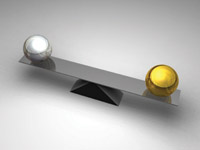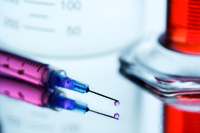Measurement in medicine - a delicate balance
20 Jul 2010 by Evoluted New Media
The science of measurement is supporting the medical industry – Courtney Tuffin explains how
The science of measurement is supporting the medical industry – Courtney Tuffin explains how
 Optical technologies are the cornerstone of many modern techniques for diagnosis and treatment of disease. But such techniques require incredible accuracy. Minor variations in scanning technologies can miss the affected cells they are looking for and delay life-saving treatment. Incorrect doses of radiation can harm the cancer patients they were trying to treat.
Optical technologies are the cornerstone of many modern techniques for diagnosis and treatment of disease. But such techniques require incredible accuracy. Minor variations in scanning technologies can miss the affected cells they are looking for and delay life-saving treatment. Incorrect doses of radiation can harm the cancer patients they were trying to treat.
Measurement for health underpins the more reliable and efficient diagnostic and therapeutic techniques. Doctors and medical scientists must be able to rely on their equipment to do their job correctly. Manufacturers of new technologies must ensure their machines are sufficiently accurate to guarantee that hospitals can trust the results.
Errors here can be costly. Where instruments are out of tolerance, they may give false information. In some industries this means customer dissatisfaction, increased warranty costs and audit failures. In the field of medical treatment or diagnostics, it could mean a missed opportunity to save lives.
A key factor in developing and maintaining medical equipment of sufficient accuracy is correct and continued calibration, which involves comparison of the device against an equal or better standard. To meet this requirement there is a wealth of regulations, calibration services and research, to ensure techniques not only deliver sufficient accuracy but are continually improving to deliver better care to patients and ease the burden on hospitals.
At the heart of this are National Measurement Institutes – in the UK, The National Physical Laboratory (NPL). Measurement Institutes support healthcare and associated industries to ensure such technologies meet the rigorous standards required of them. They offer industry access to a suite of facilities and a team of experts to support development and maintenance of such technologies.
One technique beginning to take off with the help of precise measurement is Optical Coherence Tomography (OCT). OCT looks beneath the surface of certain materials, notably human tissue. It is higher resolution and much quicker than techniques such as MRI or ultrasound, with no ionising radiation. This makes it ideal for detecting changes in tissue structure which can indicate early stages of cancer, and is beginning to have big implications in the dental industry for detecting decay.
However such imaging requires high precision and any inaccuracy can lead to incorrect assumptions, for example about cell disruption. This can mean missing opportunities for early, potentially life-saving, treatment.
NPL is addressing this by developing a new product called a ‘point-spread phantom’ to eliminate the risk of such errors. The phantoms are translucent cylinders of resin containing tiny particles designed to reflect light in a very specific way. By viewing the phantom with an OCT machine and analysing the image with NPL software, users can be certain the machine is producing accurate images, which can be relied upon for important medical decisions.
These ‘phantoms’ will also allow manufacturers of OCT technology to meet the necessary standards to guarantee hospitals that their machines are sufficiently accurate. This will help speed the route to market of new products using this important technology, and assure hospitals of their ongoing reliability.
It’s not just new products that need innovative methods of calibration to ensure they are developed accurately. Existing products must also be kept aligned to national measurement standards to ensure they meet regulations and provide reliable results.
Take X-rays for example. Over 40 million diagnostic X-ray examinations take place in the UK each year. In diagnostic procedures, the radiation dose received by the patient is an unwanted side effect and should be minimised, subject to an acceptable image quality being achieved. There is considerable evidence that doses received by patients for a given examination can vary considerably from clinic to clinic, however the Ionising Radiation (Medical Exposure) Regulations, introduced in May 2000, require a dose reference level to be set for each procedure in every clinic and a demonstration of consistent dosimetry.
There is considerable evidence that doses received by patients for a given examination can vary considerably from clinic to clinic, however the Ionising Radiation (Medical Exposure) Regulations, introduced in May 2000, require a dose reference level to be set for each procedure in every clinic and a demonstration of consistent dosimetry.
As part of the infrastructure for compliance with these regulations, NPL set up a calibration service for diagnostic X-ray dosimeters. This allows the medical industry to meet regulations and ensure the safety of equipment by comparing radiation doses to those traceable to national standards.
Other examples of diagnostic techniques are those using radionuclides. Again this depends critically on accurate measurement of the activity administered to patients. It is important that activity measurements can be made quickly and are shown to be traceable to national and international measurement standards.
In most cases, such measurements are made in hospitals using a relatively simple device called an ionisation chamber, which provide extremely reliable, efficient and economic measurement standards to the medical community. But such devices, whilst fine for everyday use, cannot maintain the accuracy of a dedicated measurement laboratory. For that reason, all such devices in UK hospitals are calibrated using reference materials or other standards from NPL, which in turn have been calibrated against NPL's primary standards.
The calibration intervals for such technologies are determined by manufacturer recommendations, typically based on parameters like mean drift rates for the various components within the instrument. However other factors also come into play such as required accuracy versus instrument’s accuracy; the impact an out-of-tolerance instrument will have on the process; and performance history of the particular instrument in your application. All of these must be taken into account when making important decisions about calibration of medical equipment.
Measurement is not just important in diagnostics, but in treatment itself. Every year 200,000 people are diagnosed with cancer in England, and are treated with radiotherapy, chemotherapy and surgery.
Radiotherapy treatment is given to about half of all patients, with the intent to cure the cancer or to alleviate suffering. It is essential that the correct amount of radiation (absorbed dose) be delivered to the patient: too small a dose and one or more cancerous cells may survive, leading to recurrence of the disease; too large a dose and healthy tissue surrounding the tumour may be destroyed. Optimal treatment of, for example, some head and neck tumours, requires that the dose delivered should be within only a few percent of that prescribed.
While modern techniques can deliver precise doses of radiation to tissue, this will only be the case if the equipment is stable and accurate. Regular and precise calibration of radiotherapy apparatus is therefore an essential procedure for anyone producing or using such equipment.
Every treatment is monitored with instruments, whose calibration can be traced back, via accurate secondary standard dosimeters, to primary standard instruments held at national standards laboratories such as NPL. Radiotherapy facilities can then send their secondary standards — such as ionisation chambers — for calibration against primary standards.
The clinical electron linear accelerator (linac) is used to calibrate radiotherapy. Installed in 2008 at NPL, it’s highly stable beams and accurate doses enable calibrations with smaller uncertainties. The linac can calibrate the full range of beam qualities currently in therapeutic use in the UK in a very short period of time. The facility is also employed for training in dosimetry techniques. This allows hospitals and manufacturers to deliver more accurate and effective radiation doses to cancer patients.
These standards measure absorbed dose directly from first principles. To ensure their continued accuracy, they are subject to regular comparisons with other national standards worldwide.
Measurement may not be the first thing that springs to mind when you think about medical diagnosis and treatment, but it is an essential part of it. Most modern clinical decisions, from diagnoses, to treatments, are based on advanced pieces of technology which take patient readings. To provide meaningful data on which life-saving decisions are made, these have to be incredibly accurate. To achieve this accuracy they have to be tested against agreed international standards, held at national laboratories such as NPL.







